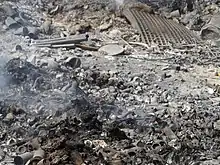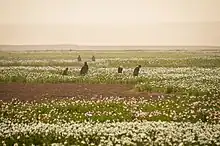The ongoing environmental impacts of war in Afghanistan, from the 1979 beginning of the Soviet-Afghan War to the 2021 United States' withdrawal from Afghanistan, adversely affect the health of Afghan civilians and American veterans, infrastructure, the labour force, and social structures.[1][2] Environmental impacts involve but are not limited to the open-air burn pits of the United States Department of Defense (DoD) and the degradation of traditional irrigation systems.[1][2] The burn pits produced hazardous emissions inconclusively linked to later appearances of chronic and sometimes fatal illness.[3][4] Irrigation impacts—significant due to the dryness of the land—have been catalyzed by military activity and the societal effects of conflict; they have contributed to the rise of Afghan opium production.[2]
Open-air burn pits

Open-pit burning was the dominant method used by the DoD to dispose of waste from their military bases in the US War in Afghanistan until 2013.[1][5] Trash was set afire on open fields using JP-8 jet fuel and diesel as propellants.[6][7] The open-air burn pits were unregulated and unmonitored. Waste consisted of materials that the DoD had deemed as hazardous and prohibited, including plastics, aerosol cans, tires, metals, and batteries.[5][8] In 2010, the DoD was burning approximately 12 700 kilograms of waste from Forward Operating Base Salerno daily, among 184 burn pits.[1] Their burning, in proximity to Afghan communities and farmland, produced toxic fumes containing volatile organic compounds (VOCs), particulate matter (PM), polycyclic aromatic hydrocarbons (PAHs), dioxins, and acrolein, contaminating air, food crops, and waterways, leading to external, inhalation, or ingestion exposure.[1][4] Immediate effects included skin, eye, and throat irritation or pain and difficulty breathing.[9] Long-term exposure has been associated with lung damage, neurological disorders, cancer, respiratory, cardiovascular, and autoimmune diseases, although causal links remain inconclusive due to limited data.[3][9][10] The severe and long-term health outcomes associated with open-pit burning for Afghan civilians and US military veterans have been likened to the effects of Agent Orange in the Vietnam War.[1]
Irrigation systems

Between 1979, the time of the Soviet invasion and 2014, the end of the International Security Assistance Force in Afghanistan, hectares of irrigated land declined by 40%.[2][11][12] The failure of irrigation systems can be attributed to the physical destruction and social, economic, and political consequences of wars in this period.[2] Irrigation operation and maintenance were once a part of a collective and communal system of labour, governed by the mirab, a part of traditional irrigation governance. However, erosion of social relations due to tension and distrust produced in conflict and Mujahideen followed by Taliban insurgent control have impaired the governance system.[2][13][14][15] The institutional and economic collapse has been particularly disruptive given the labour and financial intensiveness of traditional irrigation systems such as the karez.[2][13][15] This collapse, and the violence, have also driven migration away from karez systems, which are located in rural areas, diminishing the transmission of irrigation knowledge.[2][11] Furthermore, karez tunnels have been damaged by blasting in the Soviet and Afghan militaries' underground warfare, US military bases constructed atop them, and Soviet destruction of the countryside—where insurgencies originated.[2][11]
Opium cultivation

The dilapidated irrigation systems are a part of a constellation of environmental factors which have, in part, driven the boom of opium production in Afghanistan beginning at the time of the Soviet invasion.[2][12][14] The lack of irrigation, in combination with the Soviet destruction of orchards and farmland, the irrigation dependency of over 70% of Afghan crops due to the aridness of the region, and increasingly severe drought have caused wheat, cereal crop, and pasture failure.[2][11] These consequences have given rise to food insecurity and losses of livestock and livelihood.[2][11] The resultant debt, paired with the dominance of agriculture in the Afghan economy and the inequity and economic instability imparted by war, has incentivized farmers to shift from livestock to poppy farming.[2][11] Poppies are hardier, requiring approximately 80% less water than licit crops, and have an assured value on the global market.[2][14] Thus, farmers accredit poppy cultivation for their ability to keep their land.[2]
See also
References
- 1 2 3 4 5 6 Bonds, Eric (2015-09-25). "Legitimating the environmental injustices of war: toxic exposures and media silence in Iraq and Afghanistan". Environmental Politics. 25 (3): 395–413. doi:10.1080/09644016.2015.1090369. ISSN 0964-4016. S2CID 154998558.
- 1 2 3 4 5 6 7 8 9 10 11 12 13 14 15 Parenti, Christian (2015). "Flower of War: An Environmental History of Opium Poppy in Afghanistan". SAIS Review of International Affairs. 35 (1): 183–200. doi:10.1353/sais.2015.0000. ISSN 1945-4724. S2CID 152685552.
- 1 2 "AN ASSESSMENT OF THE POTENTIAL HEALTH EFFECTS OF BURN PIT EXPOSURE AMONG VETERANS". www.govinfo.gov. U.S. Government Publishing Office. 2019. Retrieved 2022-07-16.
- 1 2 Mallon, COL Timothy M.; Rohrbeck, MAJ Patricia; Haines, MAJ Kevin M.; Jones, Dean P.; Utell, Mark; Hopke, Philip K.; Phipps, Richard P.; Walker, Douglas I.; Thatcher, Thomas; Woeller, Collynn F.; Baird, Coleen P. (August 2016). "Introduction to Department of Defense Research on Burn Pits, Biomarkers, and Health Outcomes Related to Deployment in Iraq and Afghanistan". Journal of Occupational & Environmental Medicine. 58 (8): S3–S11. doi:10.1097/jom.0000000000000775. ISSN 1076-2752. PMID 27501101. S2CID 4138527.
- 1 2 VA, SPECIAL INSPECTOR GENERAL FOR AFGHANISTAN RECONSTRUCTION ARLINGTON (July 2014). Shindand Airbase: Use of Open-Air Burn Pit Violated Department of Defense Requirements. OCLC 913589431.
- ↑ Furlow, Bryant (January 2020). "American Thoracic Society calls for more research into military deployment respiratory exposures". The Lancet Respiratory Medicine. 8 (1): 17. doi:10.1016/s2213-2600(19)30424-2. ISSN 2213-2600. PMID 31740336. S2CID 208164373.
- ↑ Szema, Anthony; Mirsaidi, Niely; Patel, Bhumika; Viens, Laura; Forsyth, Edward; Li, Jonathan; Dang, Sophia; Dukes, Brittany; Giraldo, Jheison; Kim, Preston; Burns, Matthew (2015-12-14). "Proposed Iraq/Afghanistan War-Lung Injury (IAW-LI) Clinical Practice Recommendations: National Academy of Sciences' Institute of Medicine Burn Pits Workshop". American Journal of Men's Health. 11 (6): 1653–1663. doi:10.1177/1557988315619005. ISSN 1557-9883. PMC 5675265. PMID 26669772. S2CID 22865035.
- ↑ Office., United States. Government Accountability (2010). Afghanistan and Iraq : DOD should improve adherence to its guidance on open pit burning and solid waste management : report to Congressional requesters. U.S. Govt. Accountability Office. OCLC 671614314.
- 1 2 Administration, US Department of Veterans Affairs, Veterans Health. "Airborne Hazards and Burn Pit Exposures - Public Health". www.publichealth.va.gov. Retrieved 2022-07-16.
{{cite web}}: CS1 maint: multiple names: authors list (link) - ↑ Liu, Jason; Lezama, Nicholas; Gasper, Joseph; Kawata, Jennifer; Morley, Sybil; Helmer, Drew; Ciminera, Paul (July 2016). "Burn Pit Emissions Exposure and Respiratory and Cardiovascular Conditions Among Airborne Hazards and Open Burn Pit Registry Participants". Journal of Occupational & Environmental Medicine. 58 (7): e249–e255. doi:10.1097/jom.0000000000000776. ISSN 1076-2752. PMID 27218278. S2CID 40269053.
- 1 2 3 4 5 6 Felbab-Brown, Vanda (January 3, 2012). "Why Eradication Won't Solve Afghanistan's Poppy Problem". Brookings. Retrieved 2022-07-17.
- 1 2 Wesa, Tooryalai (2009). Afghan agricultural extension system: the impact of neglect and prospects for the future. Köln, Germany: Lambert Academic Publishing. ISBN 978-3-8383-1292-7. OCLC 707743792.
- 1 2 Iqbal, Mohammad Wasim; Donjadee, Somchai; Kwanyuen, Bancha; Liu, Shi-yin (August 2018). "Farmers' perceptions of and adaptations to drought in Herat Province, Afghanistan". Journal of Mountain Science. 15 (8): 1741–1756. doi:10.1007/s11629-017-4750-z. ISSN 1672-6316. S2CID 134912866.
- 1 2 3 Kreutzmann, Hermann (December 2007). "Afghanistan and the Opium World Market: Poppy Production and Trade". Iranian Studies. 40 (5): 605–621. doi:10.1080/00210860701667688. ISSN 0021-0862. S2CID 154035732.
- 1 2 Mahaqi, Ali (2021-07-23). "Traditional water management systems in Afghanistan: lessons for the future". Arabian Journal of Geosciences. 14 (15): 1465. doi:10.1007/s12517-021-07987-3. ISSN 1866-7538. S2CID 233808358.